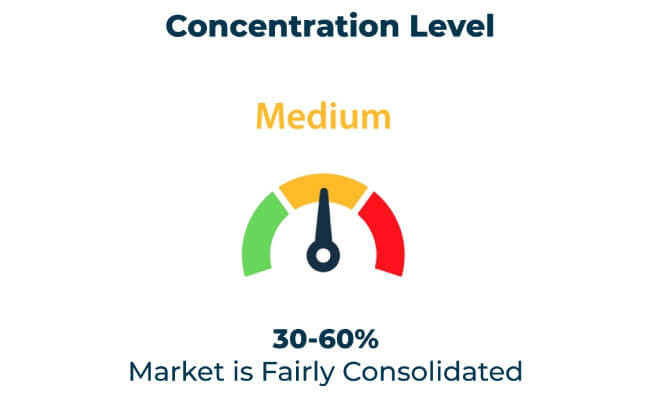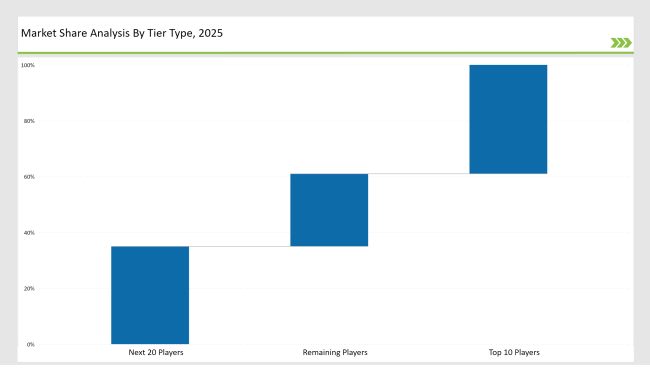The dairy packaging market has always been highly dynamic and continues to innovate, nowadays with a greater focus on freshness, food safety, and sustainability. Due to rapidly growing consumer awareness surrounding environmental issues and packaging functionality, brands are now switching to recyclable, lightweight, and tamper-evident packaging materials. Packaging plays a crucial role in maintaining the longer shelf life and, at the same time, preserving flavor and sanitation for milk, cheese, yogurt, etc.
39% of the market is retained by tier-1 manufacturers like Amcor, Tetra Pak, and Mondi Group with their innovative materials. Their global distribution network further strengthens their market presence, along with strategic alliances formed with dairy-based brands.
Tier 2 companies, such as Sealed Air, Berry Global, and DS Smith, capture 35% of the market by providing cost-effective, high-performance dairy packaging solutions across multiple categories.
Tier 3 consists of regional and niche players specializing in compostable dairy cartons, sustainable pouch packaging, and customized solutions, holding 26% of the market. These companies focus on localized production, flexible packaging designs, and enhanced food safety features.
Global Market Share by Key Players (2025)
| Category | Market Share (%) |
|---|---|
| Top 3 (Amcor, Tetra Pak, Mondi Group) | 20% |
| Rest of Top 5 (Sealed Air, Berry Global) | 12% |
| Next 5 of Top 10 (DS Smith, SIG Combibloc, Coveris, Smurfit Kappa, UFlex) | 7% |

Dairy solutions packaging is applicable to various segments where one needs utmost care for freshness, safety, and sustainability. Companies are developing new packaging formats to meet shifting consumer preferences and regulations.
Manufacturers are optimizing dairy packaging with sustainable materials, intelligent designs, and enhanced protection features.
Because of innovations centered around sustainability and food safety, dairy product packaging is being redefined at present. Firms are now using AI-enabled quality control systems, biodegradable packaging materials, and smart labeling systems to provide freshness tracking and thereby minimize food wastage.
Year-on-Year Leaders
Technology suppliers should focus on automation, sustainable material innovation, and intelligent packaging solutions to support the evolving dairy packaging market. Partnering with dairy producers and retailers will drive adoption.
| Tier Type | Example of Key Players |
|---|---|
| Tier 1 | Amcor, Tetra Pak, Mondi Group |
| Tier 2 | Sealed Air, Berry Global, DS Smith |
| Tier 3 | SIG Combibloc, Coveris, Smurfit Kappa, UFlex |

Leading manufacturers are advancing dairy product packaging with high-barrier protection, smart labeling, and AI-driven quality control.
| Manufacturer | Latest Developments |
|---|---|
| Amcor | Launched fully recyclable high-barrier dairy packaging in March 2024. |
| Tetra Pak | Introduced plant-based bioplastic dairy cartons in April 2024. |
| Mondi Group | Expanded resealable, tamper-evident containers in May 2024. |
| Sealed Air | Innovated vacuum-sealed cheese packaging in June 2024. |
| Berry Global | Strengthened sustainable dairy pouch packaging in July 2024. |
| DS Smith | Released biodegradable dairy cartons in August 2024. |
| SIG Combibloc | Developed smart packaging with real-time freshness monitoring in September 2024. |
The dairy product packaging market is evolving as companies focus on sustainable materials, digital integration, and extended food preservation technologies.
Artificial intelligence will continue to be integrated into quality control, innovative sustainable raw materials, as well as intelligent packaging solutions in the future. With stricter regulations, companies will be moving faster towards compostable as well as reusable packaging formats in dairy. Additional investments in improving supply chain visibility through blockchain tracking and interactive consumer packaging will be made.
Leading players include Amcor, Tetra Pak, Mondi Group, Sealed Air, Berry Global, DS Smith, and SIG Combibloc.
The top 3 players collectively control 20% of the global market.
The market shows medium concentration, with top players holding 39%.






Full Research Suite comprises of:
Market outlook & trends analysis
Interviews & case studies
Strategic recommendations
Vendor profiles & capabilities analysis
5-year forecasts
8 regions and 60+ country-level data splits
Market segment data splits
12 months of continuous data updates
DELIVERED AS:
PDF EXCEL ONLINE
Dairy Container Market Analysis Size and Share Forecast Outlook 2025 to 2035
Dairy Alternatives Market Analysis - Size, Share, and Forecast Outlook 2025 to 2035
Dairy Filtration Systems Market Size and Share Forecast Outlook 2025 to 2035
Dairy Ingredients Market Size and Share Forecast Outlook 2025 to 2035
Dairy Concentrate Market Forecast and Outlook 2025 to 2035
Dairy Testing Services Market Analysis - Size, Share, & Forecast Outlook 2025 to 2035
Dairy-Free Smoothies Market Analysis - Size, Share, and Forecast Outlook 2025 to 2035
Dairy-Based Dressings Market Analysis - Size, Share, and Forecast Outlook 2025 to 2035
Dairy-Free Spreads Market Analysis - Size, Share, and Forecast Outlook 2025 to 2035
Dairy Blends Market Analysis - Size, Share, and Forecast Outlook 2025 to 2035
Dairy Whiteners Market Analysis - Size, Share, and Forecast Outlook 2025 to 2035
Dairy Enzymes Market Trends - Innovations & Demand 2025 to 2035
Dairy Flavors Market Trends - Growth & Industry Forecast 2025 to 2035
Dairy-Free Evaporated Milk Market Analysis by Application, Type, Sales Channel Through 2025 to 2035
Dairy Protein Crisps Market Flavor, Packaging, Application and Distribution Channel Through 2025 to 2035
Dairy-Free Cream Market Insights – Plant-Based Dairy Alternatives 2025 to 2035
Dairy Snacks Market Growth - Consumer Preferences & Industry Trends 2025 to 2035
Dairy Machine Market
Dairy Processing Equipment Market Outlook – Growth, Demand & Forecast 2023-2033
Dairy Free Shortening Market

Thank you!
You will receive an email from our Business Development Manager. Please be sure to check your SPAM/JUNK folder too.
Chat With
MaRIA